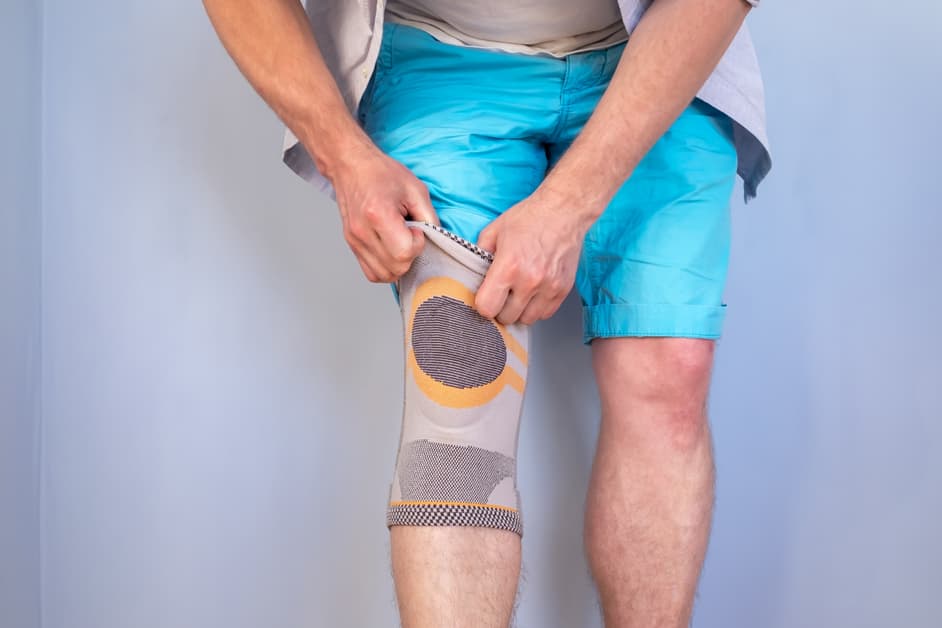Introduction
Managing knee joint pain? It’s key to have the right support. A knee brace that fits your needs gives you compression, stability, range of motion and comfort. How to pick one? Learn what type works for your condition.
This guide explains how to choose a knee brace for optimal pain management. It covers types, features, benefits, and finding the right fit for you:
Types of Knee Braces
Knee pain relief? Yep, there’s help. Different types of knee braces exist. Choice depends on condition, needs, lifestyle. Ranging from simple elastic bands to rigid with adjustable straps. Let’s dive into the types of knee braces and how to pick the right one.
Knee Immobilizer Brace
Knee immobilizers are often prescribed for patients with severe knee injuries, like fractures or ligament tears. They offer protection from movements that could cause harm. This type of brace helps keep the knee joint stable, enabling it to heal without further injury to muscles and tissues. Depending on the severity of the injury, an immobilizer can be worn for weeks or months.
The brace has adjustable straps that offer support but not too much that it causes pain. It is made from lightweight, durable materials, like neoprene and elastic bands. It comes in several sizes so it fits tight and secure around the leg.
It provides compression to reduce swelling and supports ligaments and tendons as they heal. Knee immobilizers offer stability while standing or walking. However, they should not be used while doing sports that involve cutting or maneuvering as it can cause further damage.
Hinged Knee Brace
Hinged knee braces offer added stability and support. Metal hinges on both sides keep the knee in a neutral position, avoiding overextension or overbending. Doctors often suggest hinged knee braces for ligament or tendon damage. They come in various sizes and styles, with adjustable straps for individual customization and comfort.
Depending on your needs, they might be recommended for daily use, to reduce pain during activities like running, jumping, or lifting heavy objects.
Patella Stabilizing Brace
Patella stabilizing braces, also known as jumper’s knee braces and patellar tendonitis braces, can help relieve pain caused by knee issues such as runner’s knee, tendonitis and patellar tracking issues.
They have two straps that fit around the lower leg and attach with a Velcro fastening system. This gives compression to the leg muscles and helps reduce inflammation and improve circulation.
The braces are adjustable so you can customize them to your needs. They are beneficial for people who do activities such as running, cycling and any activity involving repetitive knee motion.
They are lightweight and comfortable, making them suitable for everyday use if needed. They are best for mild discomfort or prevention of further injury due to overuse or weak quadriceps muscles.
Knee Sleeve
Knee sleeves are a popular pick for pain control. They are often made out of neoprene and provide compression to the joint for support. They also promote warmth and reduce swelling. These sleeves come in different levels of compression to better fit individual needs.
Knee sleeves can be worn for all types of activities. From work or PT to sports or just at home. They won’t give significant stabilization, but they can help manage swelling and improve comfort when doing activities that irritate an existing knee condition.
Knee sleeves are also relatively cheap. A good option if you want milder support, but need to watch your budget.
Factors to Consider when Choosing a Knee Brace
Searching for a perfect knee brace? It’s possible! There’s an array of knee braces on the market. You gotta comprehend the features and functions of each type to make sure it suits your requirements.
Here are the key points to consider when selecting a knee brace for pain control:
Level of Activity
When picking a knee brace, it’s key to think about the activity. For instance, a brace for a football player needs a different design than one for someone who takes walks. Knee braces differ in support and protection and are usually labeled active wear, moderate support, or maximum protection.
- Active wear are for light activities or sports with minimal to moderate intensity. They give light compression and stabilization, and cover just the kneecap area to keep the joint warm and make movements easy.
- Moderate support braces provide extra cushioning around the kneecap. These offer more stability since they wrap around the knee joint more fully. They’re great for activities with more intensity or repetitive movements such as running or aerobics.
- Maximum protection braces have full coverage from ankle to thigh, adjustable and secure fasteners, and adjustable shock absorbers. These are best for activities with heavy impact such as football, martial arts, and skiing.
Level of Support Needed
Choosing the right knee brace is important for optimal results. Consider factors like your age, activity level, source of pain and severity when deciding how much support you need.
- Young, active people with issues like osgood schlatter’s disease or patellar tendonitis may be suited to a hoop-and-loop strap brace. This type of brace fits snugly and can be tightened for extra stability.
- For mild arthritis or joint instability due to meniscus tears or ACL injuries, unloader braces can reduce force on joints while maintaining range of motion. These braces feature an external hinge for stress offsetting.
- For advanced arthritis or severe joint instability due to major trauma, heavy-duty functional braces may be helpful. Consult your orthopedic specialist before opting for these rigid braces. They can recommend an option tailored to your needs.
Comfort
Comfort is key when picking a knee brace. There are many types, some offering more support than others. It’s important to find one that fits snugly yet is comfortable for extended periods. The material should be soft to avoid chafing or rubbing, and look for breathable fabric that wicks away moisture. These features guarantee comfort, no matter what you do wearing the brace.
Cost
When it comes to knee braces, cost is crucial. Prices can vary greatly, depending on type, material, and brand. Traditional braces are usually less costly and may be covered by insurance. Advanced ones like custom and dynamic braces will be more pricey. Remember: expensive doesn’t always mean better. Talk to a doctor or specialist to find out which type is right for you. There are also generic brands that provide good support, without costing a lot.
Take time to research products and prices to get the perfect brace in your budget:
- Compare types and materials.
- Check insurance coverage.
- Research generic brands.
Conclusion
Data from scientific literature suggests that the most useful knee braces for reducing pain during daily activities are prefabricated and over-the-counter straps. The best type of brace depends on the functional demands of your activities, how often they are done and how bad your knee pain is.
It is important to get assessed by a healthcare professional. They can accurately assess the effects of braces on your knee. Plus, they can give personalized advice on which type of brace would be best and offer other recommendations to enhance its effectiveness. Additionally, they can give feedback on form, fitment and comfort, aiding in a successful outcome with any particular product:
- Assessment of the effects of braces on your knee.
- Personalized advice on which type of brace would be best.
- Recommendations to enhance the effectiveness of the brace.
- Feedback on form, fitment and comfort.
Frequently Asked Questions
Question 1: What types of knee braces are available?
Answer: There are a variety of knee braces available, including hinged, elastic, neoprene, and unloader braces. Each type of brace provides different levels of support and stability, depending on the user’s needs.
Question 2: How do I know what type of knee brace is best for me?
Answer: It is important to consult a doctor or physical therapist to determine which type of knee brace is best for you. Your doctor can assess your individual needs and recommend the most appropriate type of brace.
Question 3: Are knee braces covered by insurance?
Answer: It depends on your health insurance plan. Some plans may cover the cost of a knee brace, while others may not. It is best to check with your health insurance provider to find out if a knee brace is covered.





